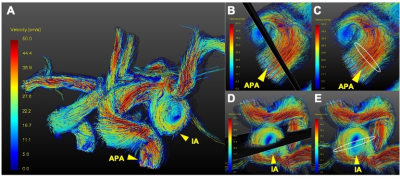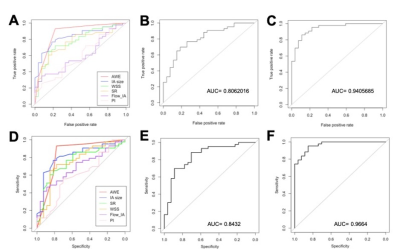Miaoqi Zhang1, Mingzhu Fu1, Hanyu Wei1, Shuo Chen1, and Rui Li1
1Center for Biomedical Imaging Research, Department of Biomedical Engineering, Tsinghua University, Beijing, China
1Center for Biomedical Imaging Research, Department of Biomedical Engineering, Tsinghua University, Beijing, China
intracranial aneurysm, 4D-Flow MRI, black blood MRI, Support Vector Machines model

Figure.1 Flow pattern visualization of the intracranial aneurysm (IA) and adjacent parent artery (APA) were performed by (A) streamlines, maximum velocity point and the largest cross-section of IA were showed in (B) APA and (D) IA. Hemodynamic measurements within contours were conducted in (C) APA and (E) IA.

Figure.3 The receiver operating characteristic (ROC) curves of logistic regression models: (A) Single characteristic predict stable IA using GLM model, (B) hemodynamic characteristics predict stable IA using GLM model (C) six significant characteristics predict stable IA using GLM model. (D-F) SVM model respectively. (D) Single characteristic predict stable IA using SVM model, (E) hemodynamic characteristics predict stable IA using SVM model (E) six significant characteristics predict stable IA using SVM model.